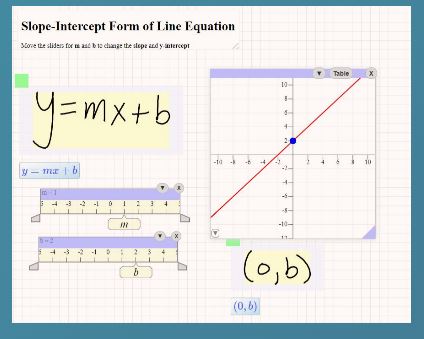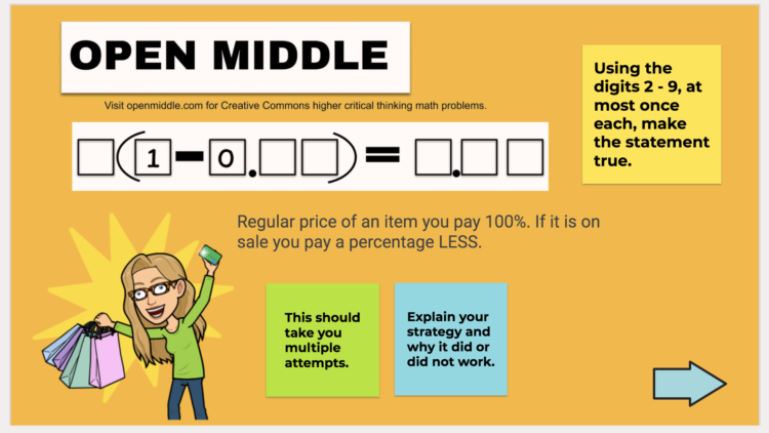As a former ELA teacher, math instruction has always seemed like the quest for the Grail to me. First off, the content seems very foreign (at least to me!) and then there is the great need for paper and pencil to do the work with. Of course, in today’s classroom, math education is just as innovative as any other subject area due to a large number of excellent tools available for the students. In this blog, I share some math resources that you may not be familiar with.
Collaborative Math Tools
Math Whiteboard is a fabulous, free, collaborative tool designed specifically for math education. It allows the teacher, who shares a link to a collaborative board, to see the work of every student at one time. You can import PDFs for students to work on and annotate, use the included graphing calculator, take advantage of the powerful Computer Algebra System that allows for calculations from arithmetic to calculus, and write or type math formulas and numbers. The site runs in any browser and so works on any device.

The Math Card Games site has more than 30 free card games that focus on place value, operations, fractions, and decimals. As the teacher, you can watch the students play in real-time, which can give you excellent feedback on their understanding. The games are really good, but it does require a little work to get started. The teacher downloads a game template and then goes to PlayingCards.io. You start a blank room and then upload the template, finally creating a copy of the game for each pair of students. (There is an excellent video on how to do all of this.) Each game also comes with a two-to-three minute video with directions on how to play.
Open Middle
If you are using the Open Middle approach in your math classroom, be sure to check its website. They have tons of resources there, including the ability to browse by standard or grade level and student worksheets in English and Spanish (downloadable in Google Slides). Each question set includes directions on how to use it, as well as hints.
There is a fantastic Depth of Knowledge Matrix based on the Open Middle concept for Algebra 2 available from Robert Kaplinsky. He also has these matrices:
- Elementary and secondary matrix (a selection from eight grade levels)
- Elementary matrix (kindergarten through 5th grade)
- Secondary matrix (6th grade through calculus)
- 3rd, 4th, 5th, 6th, 7th, 8th, Algebra 1, Geometry, and Algebra 2 matrices (separate matrices for each grade level)
Alice Keeler shares how to use Google Jamboard with the Open Middle concept. She explains the process clearly and then includes a sample problem and an example.

Elementary Math Tools
MathBots offers a variety of resources for basic math instruction, including manipulatives, question generators, puzzles, printables, and more. I really like the Starters section which offers bell ringer activities to get kids warmed up and ready to learn. It also has a great Tools section where you’ll find more than 25 different digital math resources perfect for exploratory learning or for teacher-led instruction.
The SolveMe website is all about supporting algebraic reasoning in a fun and interactive format. Students use logic to solve visual, interactive mathematical puzzles in one of three games: Mobiles (equation practice using mobiles), Who Am I (use clues to determine the digits of a mystery number), and Mystery Grid (place all the tiles on the grid so that every row and every column contains exactly one type of tile, and so that the tiles fit the clues). There are hundreds of them to solve, so it can carry your students through the whole year. Most of the games are geared toward the elementary grades. No login or registration is required.

Boddle offers a 3D math game approach with very cute characters for grades K-6. The teacher registers for a free account and then sets up her students with access. The students log in and start playing. There is also a free iOS app.
Once students have been introduced to a math concept and are needing guided practice, Zearn is a great resource. Created by a nonprofit, their digital lessons for grades 1-5 are completely free. They include short videos that explain the concept, problem-solving with interactive tools, “pause points” where students top and do math, and real-time feedback on every problem. I also like that they include kids explaining some of the concepts in the videos. Each digital lesson takes about 30 minutes to complete.

Secondary Math Tools
Typing a math formula into a Google Doc or Slide can be difficult. But that was before Equatio. This Google extension is free for teachers. I found it a little hard to use at first. But Eric Curts has a great blog with very clear instructions. (By the way, it’s also great for scientific formulas!
If these math tools aren’t enough for you, be sure to check the others mentioned in this TCEA blog. And you should also look at the long, compiled list, again from the fabulous Eric Curts, with new math resources added every month.
Protractor Tools
Check out this transparent online protractor from Ginifab.
TeachableMath shares an interactive protractor app to practice measuring angles on the screen.
Oryx has an online protractor tool built to practice measuring and estimating angles.
MathsPad is a newer interactive graphing tool that includes a protractor tool.
Happy mathing!


1 comment
Nice